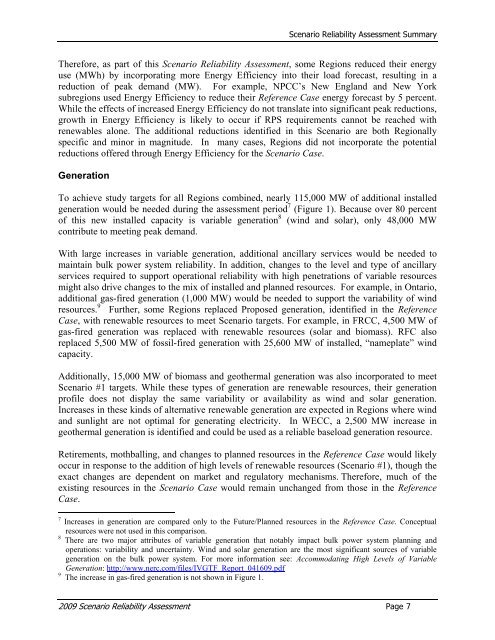2009 Scenario Reliability Assessment - NERC
2009 Scenario Reliability Assessment - NERC
2009 Scenario Reliability Assessment - NERC
- No tags were found...
Create successful ePaper yourself
Turn your PDF publications into a flip-book with our unique Google optimized e-Paper software.
<strong>Scenario</strong> <strong>Reliability</strong> <strong>Assessment</strong> SummaryTherefore, as part of this <strong>Scenario</strong> <strong>Reliability</strong> <strong>Assessment</strong>, some Regions reduced their energyuse (MWh) by incorporating more Energy Efficiency into their load forecast, resulting in areduction of peak demand (MW). For example, NPCC’s New England and New Yorksubregions used Energy Efficiency to reduce their Reference Case energy forecast by 5 percent.While the effects of increased Energy Efficiency do not translate into significant peak reductions,growth in Energy Efficiency is likely to occur if RPS requirements cannot be reached withrenewables alone. The additional reductions identified in this <strong>Scenario</strong> are both Regionallyspecific and minor in magnitude. In many cases, Regions did not incorporate the potentialreductions offered through Energy Efficiency for the <strong>Scenario</strong> Case.GenerationTo achieve study targets for all Regions combined, nearly 115,000 MW of additional installedgeneration would be needed during the assessment period 7 (Figure 1). Because over 80 percentof this new installed capacity is variable generation 8 (wind and solar), only 48,000 MWcontribute to meeting peak demand.With large increases in variable generation, additional ancillary services would be needed tomaintain bulk power system reliability. In addition, changes to the level and type of ancillaryservices required to support operational reliability with high penetrations of variable resourcesmight also drive changes to the mix of installed and planned resources. For example, in Ontario,additional gas-fired generation (1,000 MW) would be needed to support the variability of windresources. 9 Further, some Regions replaced Proposed generation, identified in the ReferenceCase, with renewable resources to meet <strong>Scenario</strong> targets. For example, in FRCC, 4,500 MW ofgas-fired generation was replaced with renewable resources (solar and biomass). RFC alsoreplaced 5,500 MW of fossil-fired generation with 25,600 MW of installed, “nameplate” windcapacity.Additionally, 15,000 MW of biomass and geothermal generation was also incorporated to meet<strong>Scenario</strong> #1 targets. While these types of generation are renewable resources, their generationprofile does not display the same variability or availability as wind and solar generation.Increases in these kinds of alternative renewable generation are expected in Regions where windand sunlight are not optimal for generating electricity. In WECC, a 2,500 MW increase ingeothermal generation is identified and could be used as a reliable baseload generation resource.Retirements, mothballing, and changes to planned resources in the Reference Case would likelyoccur in response to the addition of high levels of renewable resources (<strong>Scenario</strong> #1), though theexact changes are dependent on market and regulatory mechanisms. Therefore, much of theexisting resources in the <strong>Scenario</strong> Case would remain unchanged from those in the ReferenceCase.7 Increases in generation are compared only to the Future/Planned resources in the Reference Case. Conceptualresources were not used in this comparison.8 There are two major attributes of variable generation that notably impact bulk power system planning andoperations: variability and uncertainty. Wind and solar generation are the most significant sources of variablegeneration on the bulk power system. For more information see: Accommodating High Levels of VariableGeneration: http://www.nerc.com/files/IVGTF_Report_041609.pdf9 The increase in gas-fired generation is not shown in Figure 1.<strong>2009</strong> <strong>Scenario</strong> <strong>Reliability</strong> <strong>Assessment</strong> Page 7
















